Free Download of Step-by-Step Solutions for Class 10 Physics Chapter 9 – Household Circuits of ICSE Board (Concise – Selina Publishers).
All exercise questions are solved & explained by an expert teacher and as per ICSE board guidelines. The essential principle of power distribution is discussed in Selina Solutions Concise Physics Class 10 Chapter 9 Household Circuits. The answers are correct in terms of the principles discussed in this chapter. Students should practice textbook problems regularly to analyze the questions that will be asked on the exam. Students can use the Selina Solutions PDF to help them comprehend the concepts taught in the chapter.
Our topic experts created Selina Solutions Concise Physics Class 10 to meet the needs of students and assist them with exam preparation. Board exams are a crucial turning point in a student's life when it comes to reaching their professional goals. Students require a lot of practice to overcome their anxiety about tests and solve issues confidently in the exam. Selina Solutions Concise Physics Class 10 can be downloaded through the sources provided below.
Access ICSE Selina Solutions for 10 Physics Chapter 9 - Electrical Power and Household Circuit
Exercise- 9(A)
1. At what voltage and frequency is the electric power generated at the power generating station?
Ans: At power generating stations electric power is generated at 11 KV voltage and 50Hz frequency.
2. (a) At what voltage is the electric power from the generating station transmitted? Give reasons for your answer.
Ans: Electric power generated from the station is transmitted at 11 kV because voltage higher than because of insulation difficulties, while the voltage lower than this involves high current and loss of energy in form of heat.
(b) What is the nature of current transmitted from the power station?
Ans: Current transmitted from the power station is alternating current.
3. In the transmission of power the voltage of power generated at the generating station is stepped up from 11kV to 132kV before it is transmitted. Why?
Ans: Voltage is stepped up from 11kV to 132kV to minimize the loss of heat energy in the live wires.
4. Explain with the aid of a simple diagram, the transmission of electric power from the generating station to your house.
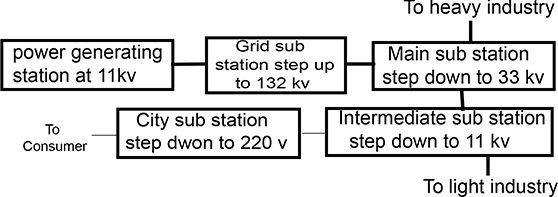
At the power generating station, 11 kV electric power is generated. The alternating voltage is supplied to the grid sub-station and stepped up to 132 kV using a step-up transformer. It is then transmitted to the main substation where the voltage is stepped down to 33 kV using a step-down transformer and then transmitted to the intermediate substation. At the intermediate sub-station, voltage is stepped down to 11 kV using a step-down transformer and it is transmitted to the city substation, where the voltage is again stepped down to 220 V and it is supplied to our houses.
5. At what voltage and frequency is the a.c. supplied to our houses?
Ans: The a.c. is supplied to our houses at voltage of 220 V and frequency of 50Hz.
6. Name the device used to (a) Increase the voltage at the generating station.
Ans: Step-up transformer
(b) Decrease the voltage at the sub-station for its supply.
Ans: Step-down transformer
7. (a) Name the three connecting wires used in a household circuit.
Ans: Three connecting wires used in a household circuit are:
(i) Live (or phase) wire (L),
(ii) Neutral wire (N), and
(iii) Earth wire (E).
(b) Which two wires mentioned in part (a) are at the same potential?
Ans: Neutral and earth wires are at the same potential.
(c) In which of the wires stated in part (a) the switch is connected?
Ans: Switches are connected to live wire.
8. What is the role fuse? Write down its current rating.
Ans: Before the electric line is connected to the meter box in a house, a fuse of rating (≈ 50 A) is connected in the live wire before the meter. This fuse is called the pole fuse. Its current rating is ≈ 50 A
9. State the function of each of the following in a house circuiting:
(a) kWh Meter
Ans: Cable from fuse wire is connected to a kWh meter and from this meter; connections are made to the distribution box through a main fuse and a main switch.
(b) Main Fuse
Ans: The main fuse is connected with live wire and in case of high value of current it will burnt and cut the connections to save appliances.
(c) Main Switch
Ans: The main switch is connected in the live and neutral wires. The main switch used to break the connection of the live wire and neutral wires from the main supply.
10. In what unit does the electric meter in a house measure the electrical energy consumed? What is its value in S.I. unit?
Ans: The electric meter in a house measures electrical energy consumed in kWh. It's S.I. unit is 1 kwh which is equal to 3.6 × 106 J.
11. Where is the main fuse connected in a house circuit?
Ans: The main fuse in our house circuit is connected in live wire before the main switch.
12. State one advantage of using the main switch in house wiring.
Ans: Main switch is double pole switch with iron covering. Major advantage of using it is, break the connection of both the live wire and the neutral wire at the same time. It protects electrical appliances from accidental damage due to electrical faults.
13. Draw a circuit diagram to explain the ring system of house wiring. State two advantages of it.
Ans:
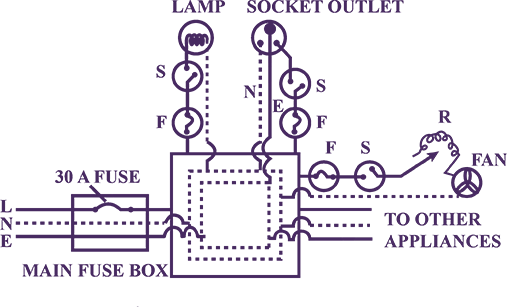
Advantages of ring system over tree system:
(i) In a ring system wiring is cheaper than a tree system.
(ii) In a ring system sockets and plugs of the same size are used while in a tree system sockets and plugs are of different sizes.
(iii) In ring systems, each appliance has a separate fuse due to which if there is any fault or fuse of one appliance burns it does not affect other appliances; while in a tree system when the fuse in one distribution line blows, it will disconnects all the appliances connected to that distribution circuit or line.
14. Draw a labelled diagram with necessary switch, regulator etc. to connect a bulb/lamp, a plug socket and a fan with the mains. In what arrangement are these appliances connected to the mains: series or parallel?
Ans:
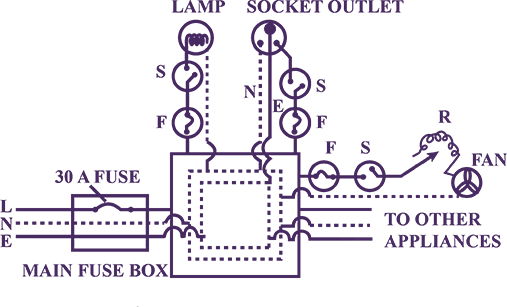
So, appliances are connected in a parallel arrangement with mains.
15. How should the several electric lamps be connected with the main so that the switching on or off in a room has no effect on other lamps?
Ans: All the electrical appliances in a house\buildings should be connected in parallel with mains and each with a separate switch and a separate fuse connected in the live wire so that the switching on or off in a room will not affect other lamps in the same building.
16. Fig. shows three bulbs A, B and C each of rating 100 W, 220 V connected to the mains of 220 V. Answer the following:
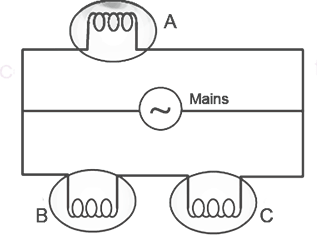
(a) How is the bulb A connected with the mains? At what voltage does it glow?
Ans: Bulb A is connected in a parallel with the mains. It will glow when voltage applied across the bulb is 220 V.
(b) How are the bulbs B and C connected with the mains? At what bulb A connected with the mains?
Ans: Bulbs B and C are connected in series with mains. Because of this series connection with the mains, the voltage at which they glow will be divided by two from the main's supply voltage. Thus, bulb B will glow at 110V.
(c) How is the glow of bulbs A and C affected if bulb B gets fused?
Ans: If bulb B will get fused, bulb C which is connected in series with will not glow. This will not affect the glow of bulb A, because it is connected parallel with the mains.
(d) How is the glow of bulbs B and C affected if bulb A gets fused?
Ans: If bulb A gets fused, the glow of bulb B and bulb C are not affected.
17. Two sets A and B each of four bulbs are glowing in two separate rooms. When one of the bulbs in set A is fused, the other three bulbs also cease to glow. But in set B, when one bulb fuses, the other bulbs continue to glow.
(i) Explain the difference in the two sets,
(Hint: in set A, the bulbs are in series; while in set B, the bulbs are in parallel)
Ans: In a set A, bulbs are connected in series. So, when the fuse of one bulb blows off, the circuit gets broken, and current will not flow through the other bulbs also. In a set B, the bulbs are connected in parallel. So, each bulb gets connected to its voltage rating (= 220 V) and even when the fuse of one bulb blows off, others remain unaffected and they will continue to glow.
(ii) Which set of arrangements is preferred in the housing circuit and why?
Ans: Set B prefers parallel combinations because the potential difference remains constant.
Multiple Choice Type
1. The main fuse is connected in:
(a) Live wire
(b) Neutral wire
(c) Both the live and earth wires
(d) Both earth and the neutral wire.
Ans: Option (a)
Main fuse is connected in live wire thus that if the current exceeds its rating, the fuse will melt and break the circuit, so it prevents the flow of excessive current into the circuit.
Correct option (a), the main fuse is connected in live wire.
2. The electrical appliances in a house are connected in:
(a) Series
(b) Parallel
(c) Either in series or parallel
(d) Both in series and parallel
Ans: Option (b)
On connecting electrical appliances in parallel, each appliance works independently without affecting whether the other appliances are switched on or off.
Correct options (b), Electrical appliances in a house are connected in parallel.
3. The electric meter in a house records:
(a) Charge
(b) Current
(c) Energy b
(d) Power
Ans: Option (c)
Electric meters in a house measure the amount of electrical energy consumed in our house.
Correct option (c) Energy
Exercise- 9(B)
1. What is a fuse? Name the material of the fuse. State one characteristic of material used for the fuse.
Ans: Electric fuse is a safety device, which is used to limit the amount of current in an electric circuit. The use of a fuse safeguards the circuit and appliances connected in that circuit from being damaged. It is made of an alloy of lead and tin because it has a low melting point and high value of resistivity.
2. Name the device used to protect the electric circuits from overloading and short circuits. On what effect of current does it work?
Ans: 'Fuse' is used to protect electric circuits from short circuiting and overloading. Electric fuse works on the principle of heating effect of current.
3. Complete the following sentences:
(a) A fuse is a short piece of wire of high _________ and of material low _________.
Ans: A fuse is a short piece of wire of high resistance and of material low melting point.
(b) A fuse wire is made of an alloy of ________ and ________. If the current in a circuit exceeds the current rating of the fuse wire it _________.
Ans: A fuse wire is made of an alloy of lead and tin. If the current in a circuit exceeds the current rating of the fuse wire it melts.
(c) A fuse is connected in ________ with the ________ wire.
Ans: A fuse is connected in series with the live wire.
(d) Higher the current rating,_______ is the fuse wire.
Ans: Higher the current rating, thicker is the fuse wire.
(e) Live wire is also called __________ wire.
Ans: Live wire is also called phase wire.
4. Why is the fuse wire fitted in a porcelain casing?
Ans: Because it is an insulator of electricity.
5. How is a fuse put in an electric circuit? State the purpose of using a fuse in a circuit.
Ans: The fuse wire is fitted between the two metallic terminals T1 and T2 in a porcelain holder (since porcelain is an insulator of electricity). This porcelain holder fits into a porcelain socket which has two metallic terminals to which the live wires of the circuit are connected. The figure shown below is the fuse arrangement.
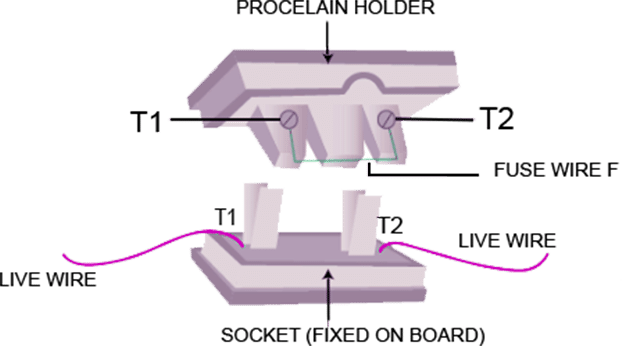
Fuse is connected with each electrical appliance to safeguard it from the flow of excessive amounts of current through it.
6. Describe with the aid of a diagram some form of a fuse, which is used in the electric lighting circuit of a house. Give two reasons why a fuse must not be replaced by an ordinary copper wire.
Ans:
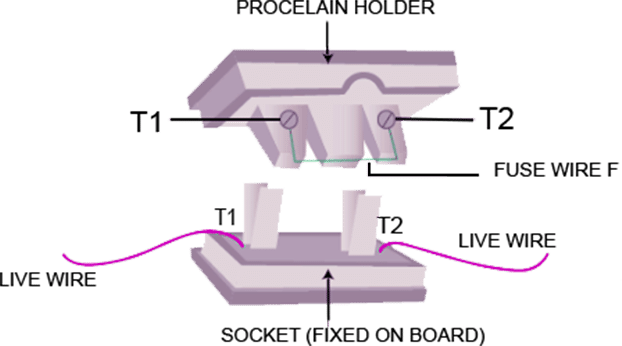
This is the most common fuse arrangement in which fuse wire is stretched between the two metallic terminals T1 and T2 in a porcelain holder. This porcelain holder is fitted into a porcelain socket which has two metallic terminals to each of which the live wire of the circuit is connected. A fuse must not be replaced with a copper wire because copper has very low resistivity and high value of melting point.
7. A fuse is always connected to the live wire of the circuit. Explain the reason.
Ans: The fuse wire is always connected with the live wire of the circuit because if the fuse is put with the neutral wire, then due to excessive flow of current the fuse burns and current will stop flowing in the circuit, but the appliance remains connected to the live wire. Now if we touch the appliance, we may get a shock as it will come in contact with the live wire through the appliance.
8. How does the (i) thickness depend on its current rating.
Ans: Current rating of the fuse wire:
(i) It is directly proportional to the thickness of wire. Thicker the fuse wire, the current rating of the fuse wire will be higher.
(ii) How the length of a fuse wire depends on its current rating.
Ans: It does not depend on its length.
9. Two fuse wires are rated 5 A and 20 A. Which of the two is (i) thicker, (ii) longer?
Ans: length of wire is directly proportional to resistance meaning longer the wire greater will be the resistance smaller the current. 20 A fuse wire will be thicker so that its resistance will be low and 5A will be longer.
10. Explain the meaning of the statement 'the current rating of a fuse is 5 A'.
Ans: It means the fuse wire connected to live wire has a current carrying capacity of 5 A.
11. (a) 'A fuse is rated 8 A'. Can it be used with an electrical appliance of rating 5 kW, 200 V?
Ans: Safe limit of current which can flow through the electrical appliance will,
I = P/V = 5000/200 = 25 A;
It is greater than 8 A. So, a fuse of 8A cannot be used.
(b) Name two safety devices which are connected to the live wire of a household electric circuit.
Ans: Switch and fuse.
12. An electric kettle is rated 3 kW, 250 V. Give reason whether this kettle can be used in a circuit which contains a fuse of current rating 13 A.
Ans: The safe limit of current for kettle will,
I= 3000 W/ 250V =12 A
So, this kettle can be used in a circuit which contains a 13 A fuse.
13. (a) What is the purpose of a switch in a circuit?
Ans: A switch is a device which has on-off the current in a circuit (or in an appliance). It should always be connected with the live wire so that the appliance could be connected to the high potential point through the live wire. In this position the circuit is complete because neutral wire provides the return path for the current. When the appliance does not work i.e., in the off mode of the switch, the path of current is incomplete and no current will reach the appliance.
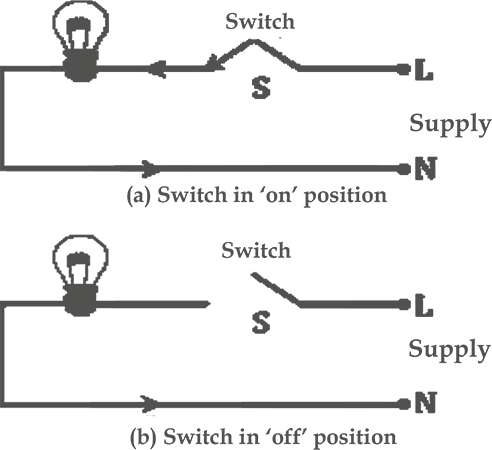
(b) Why is the switch put in the live wire?
Ans: If the switch is connected with the neutral wire, then in 'off' position, no current will pass through the bulb. But the appliance remains connected to the high potential terminal through live wire.
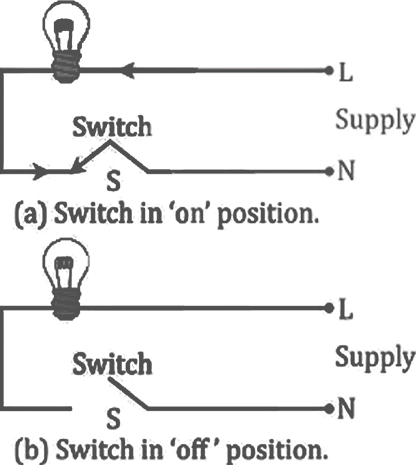
So, if the switch is connected in the neutral wire, it can be quite deceptive and even dangerous for them.
(c) What precaution do you take while handling a switch?
Ans: Precaution while handling a switch the switch should not be touched with wet hands.
14. (a) A switch is not touched with wet hands while putting it on or off. Give a reason for your answer.
Ans: We should not touch a switch with wet hands. If the water reaches the live wire, it forms a conducting contact between the hand and the live wire of the switch so the current passes to the hand and the person may get a fatal electric shock.
(b) Name the wire to which a switch is connected.
Ans: Switch is connected to the live wire.
15. It is dangerous to connect the switch in the neutral wire. Explain your answer.
Ans: In case of excessive flow of current, it is dangerous to connect the switch with the neutral wire. Even if the fuse blows off due to excessive flow of current and the current in the circuit would no longer be conducted, the appliance will still remain connected to the live wire of a very high potential.
Now in this situation, if a person touches the metallic body of that appliance then he/she may suffer a fatal electric shock. That's why it is highly dangerous to connect the switch with the neutral wire.
16. Draw a diagram of a dual control switch when the appliance is switched 'ON'.
Ans:
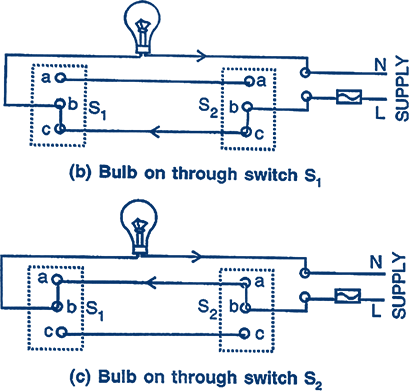
17. Draw a circuit diagram using the dual control switches to light a staircase electric light and explain its working.
Ans: Assume a switch S1 be fitted at the bottom and a switch S2 at the top of the staircase. Fig. (a) shows the position of the bulb.
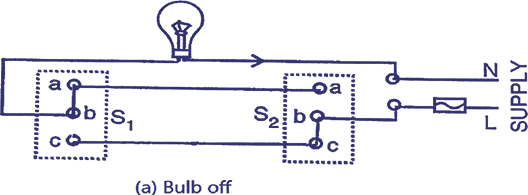
Now the bulb can be switched on independently by either switch S1 or the switch S2. If the switch S1 is on, the connection 'ab' is changed to 'bc', which completes the circuit and the bulb will glow [Fig. (b)].
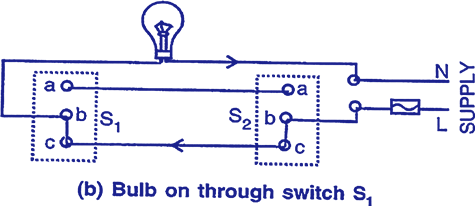
In the same way, on operating the switch S2, the connection 'bc' changes to 'ba', which again completes the circuit [Fig. (c)].
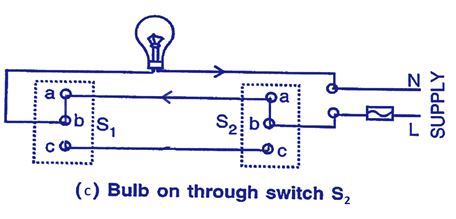
In the same manner, if the bulb is in one position as shown in Fig. (b) or (c), one can switch off the bulb either from the switch S1 or the switch S2.
18. What purpose is served by the terminals of a three way pin plug? Draw a diagram and name the pins.
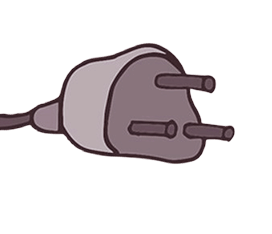
All electrical appliances are provided with a cable having a plug at one end to connect the appliance to the electric supply.
Ans: In a three way pin plug, the top pin is for earthing (E), the live pin (L) is on the left and the neutral pin (N) is on the right.
19. The diagram in fig. shows a three pin plug. Label the three pins.
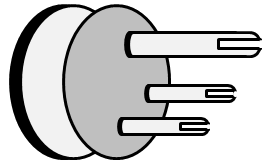
(a) Why is the top pin thicker and longer than the other two?
Ans: The three pins in the plug are:-
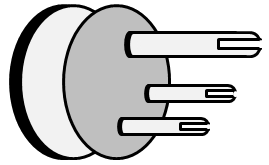
$E$ means the earth pin, $L$ means live wire, and $N$ means neutral wire. The earth pin is made long so that the earth connection is made first. This ensures the safety of the user because if the appliance is defective, the fuse will blow off. The earth pin is thicker so that even by mistake it cannot be inserted into the hole for the live or neutral connection of the socket.
(b) Why are the pins splitted at the ends?
Ans: The pins are splitted at the end to provide spring action so that they fit in the socket holes tightly.
20. Draw a labelled diagram of a three pin socket.

Ans: E: for earth pin
N: for neutral wire pin
L: for a live wire pin.
21. The diagram in Fig. shows a three-pin socket marked as 1, 2 and 3.

(a) Identify and write live (L), neutral (N) and earth (E) against the correct number.
Ans: 1 – Earth, 2 – Neutral, 3 – Live
(b) To which part of the appliance is terminal 1 connected?
Ans: Terminal 1 is connected to the outer metallic case of the appliance.
(c) To which wire joined to 2 or 3, is the fuse connected and why?
Ans: The fuse is connected to live wire joined to 3 so that in case of excessive flow of current the fuse melts first and breaks down the circuit to protect appliances.
22. What do you mean by the term local earthing? Explain how it is done.
Ans: Local earthing is made near the meter box. In earthing a 2 - 3 meter deep hole is dug into the ground then a copper rod placed inside a hollow insulating pipe, is put in the hole now a thick copper plate of dimensions 50 cm × 50cm is welded to the lower end of the copper rod and it is buried in ground. The plate is covered by a mixture of charcoal and salt for a good earth connection.
To keep the ground damp, water flows through the pipe from time to time. It forms a conducting layer between the plate and the ground. The upper end of the copper rod is connected to the earth connection at the meter box.
23. To which wire is the metallic case of an electric appliance connected? Give the reason?
Ans: If the live wire of the faulty appliance comes into direct contact with its metallic case due to any reason then the appliance gains the high potential of live wire. This may result in electric shock if any person touches the body of the appliance. But if the appliance is earthed now if the live wire comes into contact with the metallic case, high current flows through the case to the earth. The fuse connected to the appliance will also fused and the appliance gets disconnected.
24. (a) The earthing of an electric appliance is useful only if the fuse is in the live wire. Given the reason.
Ans: Fuse should be connected with live wire only if the fuse is in the neutral wire, then although the fuse burns due to the flow of heavy current, but the appliance remains at the supply voltage then touching the appliance current flows through the appliance to the person touching it.
(b) Name the part of the appliance which is earthed.
Ans: Outer case (Metallic) of the appliance must be earthed.
25. For earthing an electrical appliance, one has to remove the paint from the metal body of the appliance where the electrical contact is made. Explain the reason.
Ans: The paint on the metal body of the appliance provides an insulating layer. For earth connection therefore, the paint must be removed from the body part where connection is to be made.
26. What is the colour code for the insulation on (a) live wire?
Ans: According to new international convention
Live wire is brown in colour.
(b) What is the colour code for the insulation on neutral wire?
Ans: Neutral is light blue and
(c) What is the colour code for the insulation on earth wire?
Ans: Earth wire is yellow or green in colour.
27. Name the colour code of the wire which is connected to (i) the metallic body of an appliance.
Ans: Colour code of the wire which is connected to:
The metallic body of an appliance is connected to the earthing wire of green colour.
(ii) Name the colour code of the wire which is connected to the switch for the appliance.
Ans: The switch of the appliance is connected to the live wire of red colour.
28. How does the colour code of wires in a cable help in house wiring?
Ans: The colour coding of wires helps us to connect the switch, fuse, sockets etc. through proper wire in house wiring.
29. A power circuit uses a cable using three different wires.
(a) Name the three wires of the cable.
Ans: The three wires are: Live wire, Earth wire and Neutral wire.
(b) To which of the two wires should the heating element of an electric geyser be connected?
Ans: The heating element of the geyser should be connected to live wire and neutral wire.
(c) To which wire should the metal case of the geyser be connected?
Ans: The metal case of the geyser should be connected to earth wire.
(d) To which wire should the switch and fuse be connected?
Ans: The switch and fuse must be connected to live wire.
30. State two circumstances when one may get an electric shock from an electrical gadget. What preventive measures must be provided with the gadget to avoid it?
Ans: One may get an electric shock from an electrical gadget in the following two cases:
(i) If the fuse is put with the neutral wire instead of live wire & due to fault, if an excessive amount of current flows in the circuit, the fuse burns, current will stop flowing in the circuit but the appliance remains connected to the high potential point of the supply through the live wire. In this situation, now if a person touches the faulty appliance, he may get electric shock because the person will come in contact with the live wire through the appliance.
Preventive Measure: The fuse should always be connected with live wire.
(ii) When the live wire of a faulty appliance comes in direct contact with its metallic case due to break of insulation after constant use (or otherwise), the appliance acquires the high potential of the live wire. A person touching it will get a shock because current flows through his body to earth.
Preventive Measure: Proper 'earthing' of the electric appliance should be done.
31. Why is it necessary to have an earth wire installed in a power circuit, but not in a lighting circuit?
Ans: Power circuits carry high power and costly devices. If there is any unwanted power signal (noise) in the wire it can damage the device. To reduce this effect earth is necessary. Lighting circuits carry low power (current).So, we can ignore earth terminals.
32. Give two characteristics of a high tension wire.
Ans: A high tension wire has a low value of resistance and large surface area.
33. Which of the cables, one rated 5 A and the other 15 A will be of thicker wire? Give a reason for your answer.
Ans: To carry larger current, the resistance of the wire should be low, so its area of cross section should be large. So15 A current rated wire will be thicker.
34. The diagram in Fig. shows three lamps and three switches 1, 2 and 3.
(a) Name the switch/switches to be closed so as to light all the three lamps.

Ans: Switches 2 and 3.
(b) How are the lamps connected: in series or in parallel?
Ans: The lamps are connected in series.
35. Figure below shows a dual control switch circuit used to light a bulb.

(a) Complete the circuit so that the bulb is switched on.
Ans:
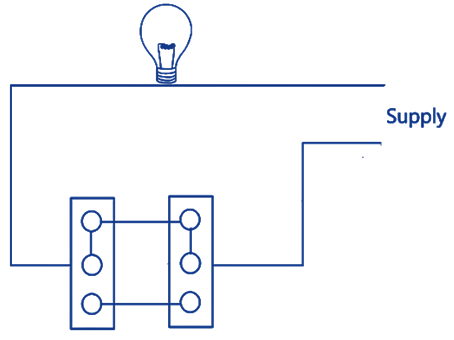
(b) Mark the supply terminal with L and N to indicate live neutral wires.
Ans:

A is live
36. Fig. Below shows two bulbs with switches and fuse connected to mains through a socket.
(a) Label Each Component.

Ans:
(a)

(b) Name and state the colour of insulation of each wire 1, 2 and 3.
Ans:
Wire no | Wire name | Colour (Old convention) | Colour (Old convention) |
1 | Neutral wire | Black | Light blue |
2 | Earth wire | Green | Green or yellow |
3 | Live wire | Red | Brown |
(c) How are the two bulbs joined: in series or in parallel?
Ans: The bulbs are joined in parallel.
Multiple Choice Type
1. The rating of a fuse connected in the lighting circuit is:
(a) 15 A
(b) 5 A
(c) 10 A
(d) Zero
Ans: Correct option is (b).
Electric wiring for lighting circuits uses a thin fuse wire of low value of current rating (=5 A) because the live wire has a current carrying capacity of 5 A.
2. A switch must be connected in:
(a) Live wire
(b) Neutral wire
(c) Earth wire
(d) Either earth or neutral wire
Ans: Correct option is (a).
A switch should be connected with live wire, so that when it is in 'off' position, the circuit is incomplete and no current will flow to the appliance through the live wire.
Free Download of Solutions for Class 10 Physics chapter 9 - Household Circuits
All questions with solutions and detailed explanations are included in Selina solutions for Concise Physics Class 10 ICSE chapter 9 (Electrical Power and Household Circuits). This will help students clear up any questions they may have and improve their application abilities as they prepare for board exams. The detailed, step-by-step solutions will assist you in better understanding of the concepts and resolving any confusion you may have. ICSE Concise Physics Class 10 ICSE solutions from Vedantu are designed to help students learn basic concepts more easily and quickly.
We also provide such solutions at Vedantu so that students can prepare for written exams. Selina textbook solutions can be a valuable resource for self-study and can provide students with excellent self-help information.
Concise Physics Class 10 ICSE Chapter 9 Electrical Power and Household Circuits cover the following topics: Earthing (Grounding), Miniature Circuit Breaker (MCB), Electric Switch, Three-pin Plug and Socket, Color Coding of Live, Neutral, and Earth Wires, Circuits with Dual Control Switches (Staircase Wire), High Tension Wires, Electrical Energy, Measurement of Electrical Energy (Expression W = Q), Electrical Power, Commercial Unit of Electrical Energy, Appliance Power Rating, Household Consumption of Electric Energy, Effects of Electric Current, Heating Effect of Electric Current, House Wiring (Ring System), Power Transmission from Power Generating Station to Consumer, Electric Fuse.
Utilizing Selina Class 10 solutions Electrical Power and Household Circuits exercises for students are a convenient way for students to prepare for exams because they include solutions organised chapter-by-chapter as well as page-by-page. The questions in Selina Solutions are important and may be asked on the final exam. Selina Textbook Solutions is preferred by the majority of CISCE Class 10 students to achieve higher exam scores.
Get a free preview of chapter 9 Electrical Power and Household Circuits Class 10 extra questions for Concise Physics Class 10 ICSE and save it for future reference.
Selina Concise Publishers prepares and publishes Concise STD 10 Physics Chapter 9 Household Circuits Books Solutions with Answers. It is a self-governing organization that advises and assists in the improvement of school education quality. You've come to the right place if you're looking for Selina Class 10 Physics Chapter 9 Household Circuits Textbooks & Solutions. Here is a comprehensive collection of Concise Class 10 Physics Chapter 9 Household Circuits solutions, which are available for free PDF download to assist students in their preparation. You can find Selina Concise STD 10 Physics Chapter 9 Household Circuits Textbooks for all subjects. These Concise Class 10 Physics Chapter 9 Household Circuits Textbooks Solutions English PDF will aid in effective education, and a maximum number of questions in exams will be drawn from Selina Concise.
Selina Solutions' Key Characteristics Household Circuits in Concise Physics Class 10 Chapter 9
Selina Solutions are written clearly. Questions at the end of the chapter allow students to assess their knowledge base.
Expertly framed Selina Solutions assist students in clearly understanding every regular method of the solution.
Students benefit from an accurate understanding of concepts when data is represented graphically.
FAQs on Household Circuits Solutions for Class 10 Physics ICSE Board (Concise - Selina Publishers)
1. Describe two scenarios in which an electric device could cause an electric shock. What precautions must be included with the device to avoid this?
An electrical device can cause an electric shock in the following situations.If the fuse is placed in the neutral wire, an excessive current flows in the circuit due to a defect in the appliance, the fuse burns, and the current stops flowing in the circuit. However, the appliance is still connected to the high potential point of the supply via the live wire. In situations like this, touching the faulty item can be dangerous for people, he will receive an electric shock because the person will come into contact with the mains via the live wire.
As a precaution, the fuse must always be connected to the live wire. When the live wire of a faulty appliance comes into direct contact with its metallic case due to insulation failure after prolonged use, the appliance acquires the live wire's high potential. A person who comes into contact with the appliance will receive a fatal shock because current flows through his body to the earth. Preventive measure: The electric appliance should be properly 'earthed.'
2. Why must an earth wire be installed in a power circuit but not in a lighting circuit?
An earth wire must be installed in a power circuit because the power circuit transports high-power and expensive devices. If there is an unwanted power signal in the wire, it can damage the device. Earth wire is required to reduce this effect and cause less damage to anything. Students can refer to the Household Circuits Solutions for Class 10 Physics ICSE Board every year regularly(Concise - Selina Publishers) for more details and in depth solutions on this topic to study better.
3. Which wire is an electric appliance's metallic case connected to? What is the reason?
When the live wire of a faulty appliance comes into direct contact with its metallic case for whatever reason, the appliance acquires the live wire's high potential. A person who comes into contact with the appliance will receive a fatal shock because current flows through his body to the earth. However, if the appliance is properly earthed, a large current flows to the earth through the appliance's case as soon as the live wire comes into contact with it. The fuse connected to the appliance's circuit blows. As a result, the appliance is disconnected from the power supply.
4. What exactly do you mean by "local earthing"? Describe how it is done.
Local earthing is performed in the home near the kWh meter. A nearly 2 – 3 meter deep hole is dug in the ground for this purpose. In the hole is inserted a copper rod covered by a hollow insulating pipe. A thick copper plate 50 cm in size is welded to the lower end of the copper rod and buried underground. To ensure good contact between the plate and the earth, it is surrounded by a mixture of charcoal and salt.
Water is poured through the pipe on a regular basis to keep the ground moist. Between the plate and the ground, this creates a conducting layer. The upper end of the copper rod is connected to the kWh meter's earth connection.
5. Connecting the switch to the neutral wire is dangerous. Explain your response.
In the event of an overcurrent, connecting the switch to the neutral wire is very dangerous. Due to the excessive current, the fuse blows and the current in the circuit ceases to flow. However, the appliance is still connected to the high potential point of the supply via the live wire. If the person touches the body of the appliance, he will now receive an electric shock. As a result, using a fuse in the neutral wire is extremely dangerous.








































